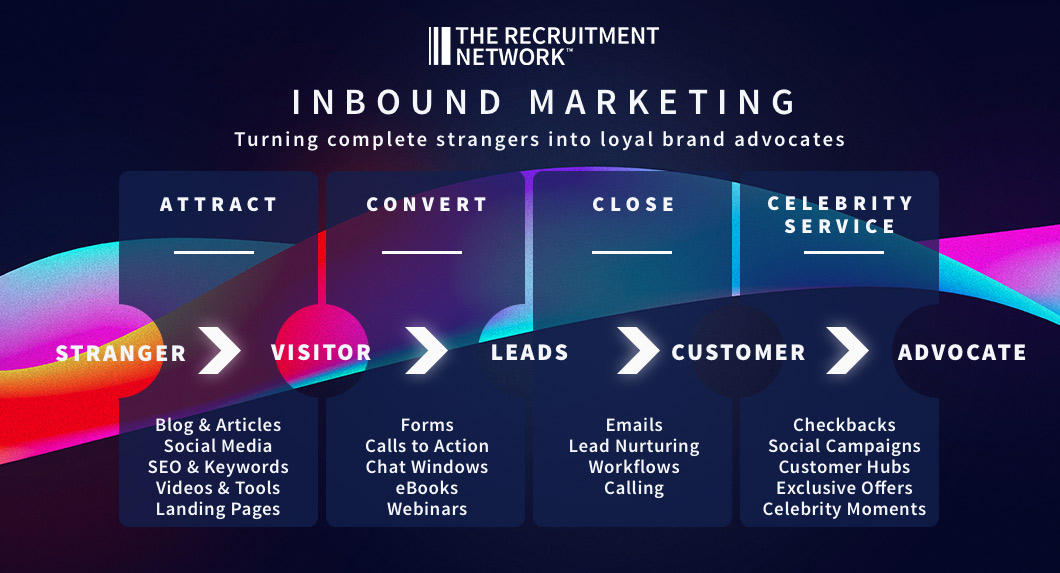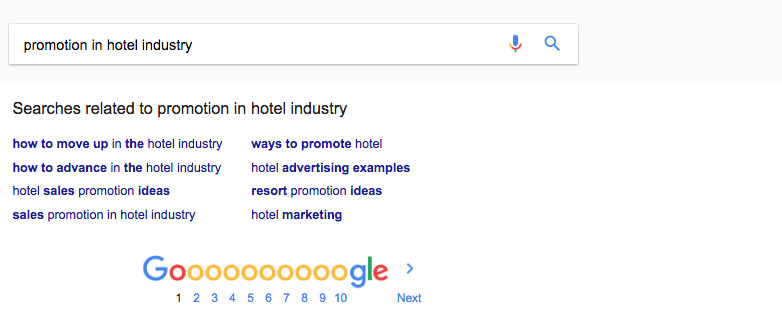We provide you with a truck-load of tips and pointers to getting started with great content marketing (How to + Free Templates)
Welcome to the second part in our Marketing for Recruitment month. Last week we went into great depth on the importance of a solid strategy and plan when it comes to marketing. We gave away a couple of templates and a bucket load of actionable tips, but now it’s time to start digging deep into some of the most important parts that will make up your marketing strategy.
This week we’re looking at content marketing and everything that’s involved when setting up a robust and results-lead content marketing strategy, from content calendars to keyword research we hope to give you the full guide so you can write, film and design your way to marketing success!
What is inbound marketing?
The days of spending chunks of money and praying are long gone. Marketing used to be about creating a compelling message and then pushing it out on various media platforms like radio, newspapers and if you were really flush, television. This is outbound marketing, and has become largely obsolete as a practice, as people have adapted to literally tune out most of these messages.
Luckily, marketing always finds a way..
This is where inbound marketing is bred from, it’s the process of creating engaging and value-adding content to attract and qualify interested leads to your website or web presence. But, it doesn’t stop there, there’s a process in turning an article reader into a customer.

The four step process of an inbound strategy works like this:
1: Attract: Creating great value-adding content and strategies that bring in the right customers, through social media. To do this stage right, create the right content, push it out at the right time to the right people, then we’re in business. This is arguably the most difficult bit, but we don’t stop there.
2: Convert: Once you’ve got the internet’s most valuable commodity; attention, it’s essential you provide the structure to continue the conversation. Do this with gated content, web forms, chat boxes and a decent CRM.
3: Close: This where you and your recruiters will shine, closing is what you do best. What’s better, if your inbound marketing efforts have worked so far, they’ll be warm leads, making that initial call much easier. Clever email nurturing, pipeline management and lead scoring will help improve and tighten up this process, making marketing worth one’s salt.
4: Celebrity Service: Once you’ve made that sale the final part of the inbound cycle is to provide a service worthy of a celebrity! Continuing conversations, providing further value and providing a platform for your customers to voice concerns. Get all of this right your candidates will become advocates or even evangelists of your company, referring and upselling themselves silly. (Think Apple)
As you can see inbound marketing is simple to explain, but putting it into practice is trickier. It’s truly a process of tweaking and hacking your process until you start seeing some tangible results.
“Why is content important? Everyone says that the most valuable candidate is the one that isn’t looking. So if you are on their radar and they think of you as that company which had the really useful salary survey – or interesting whitepaper – or which writes that really interesting blog that addresses their pain points – then you are the agency that they are going to come to when they are ready to move!”Tracey Barrett – BlueSky PR
Content is more than blog articles
When we say content, I bet the first and only thought that pops into your head is blogs, but content is so much more than the humble article. Content refers to anything that is associated with your brand, whether that’s videos, the copy on your website, podcasts, infographics, tools and much more. Knowing this fact will help broaden your understanding of what can be used in your ‘content strategy’ and inbound marketing.
When it comes to creating content it truly falls on a sweet-spot between what you feel comfortable with & what will resonate with your target audience. Never rule out the power of some more unorthodox methods of creating engaging value-adding content, whether that might be videos or audio.
Why should a recruitment agency create content?
Content is vital in this day and age, it helps your audience connect to your brand. With our industry being as crowded as it is, it’s vital we create something that provides an inherent value to your target demographics. A well crafted blog or informative video will resonate in your customers mind when they come to making the decision of who to go with.
When you get smart with your content you avoid the need to make that hard sale. Your consultants may be some of the best salesmen you know, but think about how much they could get done if they didn’t need to press the person on the phone, instead they were already sold! From candidates to clients, the right sort of content at the right time can make all the difference.
Once you’ve been doing this for a while you’ll quickly build up an impressive backlog of valuable content which can be called on at any point by all your consultants to really add that extra touch to a interaction with a client. This is definitely going to fulfill that customer experience piece as well as establish you as a expert in your field.
The power of collaborating with experts
Great content takes time, and we’re not all inherent videographers or natural born writers. For some the prospect of writing a blog conjures up a deep dread, and that means it’s going to be a uphill battle. One of the best ways to produce a steady stream of amazing content, and where we have found tremendous results, is in collaborating!
As we mentioned, establishing yourself as an expert is one of the perks of creating consistent content, but if you’re not a expert to start with, you’re lying and this is going to shine through in your content. So instead of posing as an expert, why don’t you collaborate with some existing experts to populate your website with the valuable content your audience will love.
As an example, we were really keen to cover the subject of Google Jobs, and what this meant for recruiters. This was an SEO heavy subject, something we weren’t experts in, but we knew enough to get by. So we contacted our friend, Sleeping Giant Media, an award winning agency, who specialise in all things SEO. Sleeping Giant naturally were thrilled to take part, as they saw the inherent value of collaborating with us; they get an outreach and a platform to show their knowledge to our existing database.
So after a discussion on the matter we ended up getting their CEO, Luke Quilter, to produce 2 fantastic value-packed videos all about the google jobs and what this means for the recruitment industry, needless to say they went down very well with our audience!
As recruiters I believe you’re in a very fortunate position that you can really show off your knowledge in the areas you recruit as well as flexing your industry ties by simply contacting a few of the experts (maybe even your clients) and producing some fantastic value-adding content.
Building a content calendar & the power of the planning ahead
So let’s start with the real meat of your content strategy, hopefully we’ve given you a few reasons and ideas for some clever content, but there are a few ground rules before your get started.
The first stop is the content calendar, which of course we have provided a convenient template for you to get started with straight away.
The way we use our content calendar is much like you use your regular calendar. It’s the perfect platform to plan ahead of time the type of content your want to produce, it helps give us a vision for the next 3 points.
We’ve found that when we’re not using a content calendar it really descends into chaos, instead of knowing what we need to do weeks or even months in advance, we’re coming in on a Monday thinking “Oh crap, I need to write a blog for this Wednesday” that way of working results in rushed, unresearched rubbish that doesn’t do anyone any favours.
When you’re able to peek, weeks in advanced, at your content then what you create can become smart. You can schedule in pieces of content that will coincide with notable upcoming events or initiatives.
Having a content calendar in place allows us to have initiatives like this article right here, our monthly themes where we spend a whole month covering one topic like ‘marketing in recruitment’. With our calendar, we build these articles a whole month in advance, allowing us to tweak, add and adjust our articles to create something that meets our high standards.
Getting started with the content calendar is inherently easy. Produce a list of all your content/blog ideas and then start to populate your calendar with your article ideas.

Keyword research
Another bonus with great content is google will love you and your website. Having a consistent stream of content that Google deems to be valuable will boost your SEO rating and if you hit the right keywords your articles may even come up when someone searches for the solution to a problem.
We’re going to run through our process for selecting keywords for your blog content, this exercise works twofold, it will help you find SEO keywords for your articles as well as help you come up with some ideas for future content.
1: Make a list of important and industry topics
Spend a bit of time thinking about some of the important topics you want to cover in your content strategy. This could be the recruitment specialization you focus on, or tips for candidates finding work. Try to think about what your candidates and clients are going to want to read, your customer profiles should be used here to help you make the right decision. These are generally described as ‘topic buckets’ and we’ll be filling them next with keywords.
2: Fill those important ‘topic buckets’ with keywords
Once you’ve come up with a list of 5-6 important topics to fill your topic bucket, with for an example: “Hospitality Advice” (If you were a recruiter focusing on hospitality) you would then start to brainstorm some keyword phrases people who want to know more about your topic would search. For example:
“How to get a promotion in hospitality”
“Tips for 5* hotel hospitality”
“10 things you didn’t know about delivering great service in the East”
“How do I ace my concierge interview”
Keep revisiting this time and time again, this is the step that’s going to help you fill up your content calendar with some really interesting and diverse topics throughout the year. Use this as a brain dump of all your keyword ideas and topics, we’ll finalise them later.
3: Research related key terms & topics
I always enjoy this bit, it allows me to bolster my content ideas as well as have a little spy on existing articles to get some ideas. We start by putting each topic key-phrase into google and scroll down to the bottom of the page, the suggested tab will give a list of related search times, definitely giving a few ideas.

Then I would have a look at the articles and pick out some of their top tips and bits which I can use later on when it comes to eventually producing our own version of the article, I’m not condoning plagiarising a existing article, but reusing some of their angles/ideas, in your own words.
It’s possible to push these steps even further and start to use impressive & expensive SEO tools to look up how certain keywords are ranking with competitors etc, but these 3 steps are simple and effective enough for now. This is more about coming up with some great ideas and getting those creative juices flowing.
We’ve attached a free to download of a template we use. Print it off and use it to quickly jot down some keyword ideas and phrases to get the ball rolling.

Tips for copywriting and creating a great article
Sure, video and audio make great content but let’s not beat around the bush here, blogs make up the back bone of your content and sometimes the act of actually writing your article can be a little scary if you’re not equipped with the right tips and structure. Luckily, we’re here with some of our top tips which we use everyday to get your writing like a pro!
Tip 1: Write a captivating intro.
An intro is arguably the most important aspect of your article. As we’ve said before, attention is one of the biggest commodities on the web and an intro is your best chance to cash in on that. Make sure you explain the contents of your article briefly, identify a problem and offer the a solution. Present a call-to-action or reason for the reader to finish the article. Think about how you can hook them and give them a reason to read on.
Tip 2: Create a skeleton of your article.
This transformed the way in which we wrote our articles. Think about what you want to write about and then break your article into a series of headers for the section that’ll make up your blog article.
Tip: 3 Write without any care.
Being too precious when writing when it comes to things like grammar, spelling and fancy words can stagnate your writing process. The best way to start writing is to just write without care, pound out those words as a constant stream of unconsciousness, your brain will do the work, it’s important you don’t stop to check or delete anything or worry too much.
Don’t worry about how it looks for now, it’s important to just get your knowledge and ideas down onto the document, we’ll clean it up later.
Tip 4: Go over and re-write.
Now you’ve created your big messy article it’s time to go back and be the fincity perfectionist. It’s easier to edit and adjust your article to what reads well once you’ve actually got something down. This is the process we use for all our articles and allows us to get some really big articles (like this one) built in no time.
Tip 5: Give it to someone else to proof.
The author of our article will now have run through their article 2 or 3 times adjusting and tweaking, but it’s important that you hand it over to someone who hasn’t had a part in the article and who is good at understanding grammar and spelling. Perhaps there someone in your office who is good at it or maybe you need to look into hiring a freelance proofreader from a site like fiverr.
A few other tips to nail it:
- Make sure you choose a visually appealing header image. If you’re posting on social media it’s important to have a great graphic or photograph that catches attention, think relevance and bright colors!
- Include images, graphics, gifs and videos throughout your blog. Making your article visually appealing throughout the content will help add another dimension of relevance and make the article look and feel more interesting when it comes to scrollability.
- Think about ‘Scrollability’ this is a term for the act of scrolling quickly up and down the entire content of the blog; think back, I’m sure you’ve done this a few times. This is something that happens with many readers, and if you put a little forethought into this, it’ll help you structure your subheading, paragraphs and visual elements in a way that makes the article look like a good read.
How to push out your content
Hopefully if you’ve gone through all our tips and downloaded our templates you’ve come up with a few ideas and populated your content calendar. You’ve contacted a few clients for a collaboration blog and got a few draft articles on the go (maybe you’ve also ordered a new video camera) – Whatever you’ve done, you’re going in the right direction, so i’ll leave you with a few pearls of wisdom which will help you continue your content marketing success.
Get creative: This is meant to be fun, don’t get stuck in a rut of producing boring long winded articles which don’t get your blood pumping, let alone your reader/viewers.
Keep Consistent: One of the most important foundations of a great content plan is consistency. Set a reachable goal that you make sure you hit every week or month, whether it’s 2 articles a week or a month, make sure you regularly produce content.
Don’t post and forget: I’m sure you know the importance of sharing out all your content on every social channel, or you’ll struggle to get eyes on content. But, one huge mistake a lot of people make is they post once or twice and then never post it again, which is ludicrous. We continually share all our old (relevant) content; some of our content still remains the most popular months after posting. You spend all that love and effort carefully crafting great content, then we let it collect cobwebs.
Repurpose old content: Why don’t you give your old pieces of content a new lease of life, more often than not the content we’ll produce will be evergreen, which means it’s advice that’s not going to out of date anytime soon. It’s always advisable to dust off an older article and really pump it up, whether it is with an infographic, more value, case studies, data or a video! Oh, and Google love’s a good bit of repurposing!
Next week we’re going to go into social media in more detail, from it’s importance for recruitment, to what channels you need to spend the most time on, as always it’s going to be bursting full of tips, ideas and templates to transform your marketing efforts. If you like our content then don’t forget to subscribe to our mailing list below!
Share :




